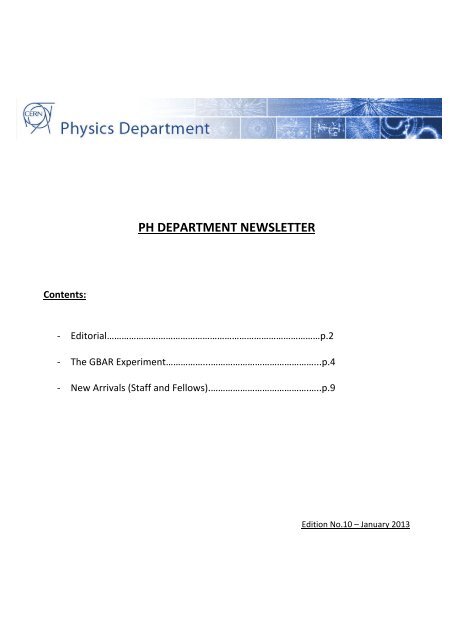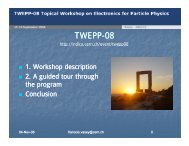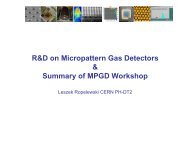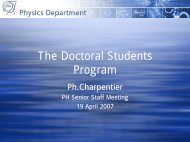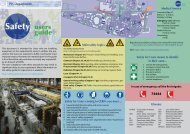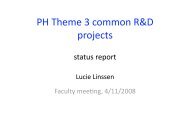January - Physics Department - Cern
January - Physics Department - Cern
January - Physics Department - Cern
Create successful ePaper yourself
Turn your PDF publications into a flip-book with our unique Google optimized e-Paper software.
Contents:<br />
PH DEPARTMENT NEWSLETTER<br />
-‐ Editorial……………………………………………………………………………p.2<br />
-‐ The GBAR Experiment……………...……………………………………...p.4<br />
-‐ New Arrivals (Staff and Fellows).………………………………….…..p.9<br />
Edition No.10 – <strong>January</strong> 2013
Editorial<br />
Dear colleagues<br />
2012 has clearly been a fantastic year for CERN and High Energy <strong>Physics</strong> in general. Of course, the discovery<br />
by ATLAS and CMS of a new particle, whose properties are so far in agreement with the postulated Higgs<br />
Boson at a mass of ~125 GeV/c 2 , has been the most prominent achievement of last year [1,2]. One should<br />
however not forget key milestones which have been passed by other LHC experiments, for example the<br />
first evidence of the rare Bs-‐>µµ decay by LHCb [3] in agreement (unfortunately!?) with the Standard<br />
Model predicted rate, the measurement of the total and elastic p-‐p cross sections at 7 and 8 TeV [4] by<br />
TOTEM, the measurement of the forward production of π 0 ’s by LHCf [5] (a key ingredient for high energy<br />
cosmic ray experiments), etc. The proton-‐lead run has just started a few days ago, but experiments have<br />
already extracted important information and published 6 papers from a few hours test last year, among<br />
which a first measurement of the nuclear modification factor [6].<br />
The non-‐LHC program was also very productive. The recent SPS Committee (SPSC) was an opportunity to<br />
review the achievements of most non-‐LHC experiments and I have been truly impressed by what was<br />
presented. For example, at the Antiproton Decelerator, ALPHA has published in Nature [7] the first<br />
observation of resonant quantum transitions in trapped antihydrogen atoms, ATRAP presented at the SPSC<br />
a new measurement of the antiproton magnetic moment with nearly 3 orders of magnitude improvement<br />
[8] and all experiments have made tremendous progress towards new hardware to perform either precise<br />
spectroscopy of antihydrogen (ATRAP, ASACUSA, ALPHA-‐2) or a measurement of the gravitational<br />
properties of antimatter (AEGIS, GBAR). In this issue, you will actually find a short paper written by the<br />
GBAR spokesperson on this new, challenging experiment, which will be performed around the ELENA<br />
decelerator starting in 2017.<br />
I could list many other examples on fixed target experiments (NA62 had its first test run, COMPASS-‐2 made<br />
a successful test run in view of the future DVCS measurements, CLOUD commissioned its expansion system<br />
for droplets and ice formation,…). Note also that in 2012 the CNGS program has been completed, as well<br />
as the DIRAC experiment. Finally, let us not forget ISOLDE who performed a record of 50 experiments and<br />
nTOF, again with a record number of 1.9 10 19 protons on target.<br />
The Theory Unit was extremely active, with one school, four TH institutes and four workshops on site and<br />
welcomed 770 visitors !<br />
Starting mid-‐February, all experiments and machines will enter into the long shutdown-‐1 with important<br />
consolidation and hardware preparation activities. This is clearly very different, but not less challenging<br />
work. Data analysis will continue in parallel, using the large data sets accumulated in 2011-‐12. In 2012,<br />
according to the database, EP produced an amazing record of 375 preprints on experimental results, just<br />
“in front” of TH with 369 preprints! More than one a day in both cases! The competition is open for 2013!<br />
I therefore wish you a happy and productive year.<br />
Philippe<br />
[1] ATLAS Collaboration, “Observation of a new particle in the search for the Standard Model Higgs boson<br />
with the ATLAS detector at the LHC”, Phys. Lett. B 716 (2012) 1, doi:10.1016/j.physletb.2012.08.020,<br />
arXiv:1207.7214.<br />
[2] CMS Collaboration, “Observation of a new boson at a mass of 125 GeV with the CMS experiment at the<br />
LHC”, Phys. Lett. B 716 (2012) 30, doi:10.1016/j.physletb.2012.08.021, arXiv:1207.7235.<br />
[3] LHCb Collaboration, First evidence of the BS-‐>m+m-‐ decay arXiv:1211.2674 ; CERN-‐PH-‐EP-‐2012-‐335<br />
2
[4] TOTEM Collaboration, A luminosity-‐independent measurement of the proton-‐proton total cross-‐section<br />
at sqrt(s) = 8 TeV CERN-‐PH-‐EP-‐2012-‐354.<br />
[5] LHCf Collaboration, arXiv:1205.4578; CERN-‐PH-‐EP-‐2012-‐145<br />
[6] ALICE Collaboration Transverse Momentum Distribution and Nuclear Modification Factor of Charged<br />
Particles in p-‐Pb Collisions at sqrt(sNN) = 5.02 TeV, arXiv:1210.4520 ; CERN-‐PH-‐EP-‐2012-‐306<br />
[7] Nature 483, 439 (2012) doi:10.1038/nature10942<br />
[8] One-‐Particle Measurement of the p Magnetic Moment, to be published.<br />
Misc. News:<br />
******************<br />
Fellows and Associates Committee Dates for 2013:<br />
The Selection Committees will take place on 24 May 2013 and 12 November 2013<br />
For May:<br />
-‐ deadline for applications -‐ Fellows, 1 March 2013<br />
-‐ deadline for applications -‐ Associates, 15 March 2013<br />
For November:<br />
-‐ deadline for applications -‐ Fellows, 3 September 2013<br />
-‐ deadline for applications -‐ Associates, 13 September 2013<br />
Technical Students Committee Dates for 2013:<br />
The Selection Committees will take place on 23 April 2013 and 1 October 2013<br />
For April:<br />
-‐ deadline for applications, 5 March 2013<br />
For October:<br />
-‐ deadline for applications, 12 August 2013<br />
******************<br />
3
GBAR - Gravitational Behavior of Antimatter at Rest<br />
The GBAR experiment, proposing a gravity measurement of antihydrogen at the planned ELENA<br />
facility, was approved by the Research Board in May 2012. The collaboration is formed of 14<br />
laboratories and about 40 researchers at present 1 .<br />
The goal of GBAR is to test the Einstein Weak Equivalence Principle (WEP), which states that the<br />
trajectory of a test particle is independent of its composition and internal structure when it is only<br />
submitted to gravitational forces. This fundamental principle has never been directly tested with<br />
antimatter. GBAR will measure the free-fall acceleration g of neutral antihydrogen atoms in the<br />
terrestrial gravitational field directly. [1]<br />
The main principle of GBAR is the use of antihydrogen H + ions (the antimatter equivalent of H –<br />
ions) to more easily manipulate the atoms before measurement. Once produced, the H + ions are<br />
cooled in two stages with lasers and Paul traps to µK temperatures, i.e. a 1 m/s velocity. We then<br />
neutralize them by photo-detachment and let the H atoms fall (Fig. 1). From a 20 cm height the time<br />
of flight is 200 ms, thus easily measured. This is complementary to the method used by the AEGIS<br />
experiment, already in preparation, that will produce a broad beam of Hs at a velocity of about 10 3<br />
m/s and detect tens of µm deviations due to gravity using a deflectometer. Both experiments aim at<br />
a 1% precision in the first phase.<br />
Our method opens the possibility of performing a spectroscopy of H quantum states. Indeed, an<br />
experiment performed ten years ago at ILL Grenoble with ultra cold neutrons by our collaborators<br />
showed that these neutrons, launched a few tens of µm above a plate, were reflected from this<br />
surface by the Casimir effect, and even trapped in the potential resulting from gravity. In such a<br />
potential well the energy levels accessible to the trapped particle are quantized, i.e. the distribution<br />
of the altitudes reached after bouncing on the surface by the particles is quantized. The separation<br />
between these altitude levels is proportional to the acceleration due to gravity. It was calculated that<br />
antihydrogen atoms of low vertical velocity when arriving on such a plate, i.e. launched a few tens<br />
of microns above it, would be reflected with very high probability, allowing thus to use the same<br />
technique to measure g with much higher precision.<br />
Figure 1 – Principle of free-fall measurement (left) and H + production scheme (right).<br />
1 CSNSM Orsay, ETH Zurich, ILL Grenoble, IPCMS Strasbourg, IRFU Saclay, Lebedev Moscow, LKB Paris, JGU<br />
Mainz, NCBJ Otwock-‐Swierk, RIKEN, Swansea University, University of Tokyo Komaba, Tokyo University of<br />
Science, Uppsala University.<br />
4
Experimental method:<br />
The H + ion is produced through two charge-exchange processes from interactions of p and H with<br />
the same positronium (Ps) target (the positronium is an e + e - bound state):<br />
p + Ps → H + e - (1)<br />
H + Ps → H + + e - . (2)<br />
The first formation cross-section may be enhanced if positronium is slightly excited (n = 2 or 3), for<br />
incident antiproton energies between 1 and 6 keV. Preliminary calculations optimising the time<br />
delays between the antiproton, positron and laser pulses, show that 1⎺H free fall can be detected per<br />
ELENA pulse, i.e every 100 s.<br />
The Ps target itself is formed by the interaction of a positron bunch with a nanoporous SiO2 layer<br />
(Fig. 1 right). We developed a layer that converts more than 30% of the incident 3 keV e + into<br />
orthopositronium (o-Ps) that is released into the vacuum. The o-Ps areal density required to obtain<br />
of the order of 1 H + ion per ELENA pulse, is ~ 10 12 cm -2 . This cannot be accomplished with the β +<br />
emitters such as the 22 Na sources used by the other antihydrogen experiments. Instead, a compact<br />
electron linac produces positrons by pair production in a target with intensity up to 100 times<br />
higher. On the other hand, the antiprotons that are decelerated in a first step to 5 MeV in the AD,<br />
then to 100 keV in ELENA, must be further decelerated to a few keV.<br />
Figure 2 - Schematic illustration of the GBAR experiment. The<br />
MeV and keV values are mean kinetic energies, while the eV and<br />
neV values are dispersions, i.e. temperatures, or quantum levels.<br />
The steps needed to perform the gravitation experiment are sketched in figure 2:<br />
- Production of an intense flux of fast positrons (few MeV) from the interactions on a tungsten<br />
target of a 10-20 MeV electron beam produced in a small accelerator.<br />
- Selection of the positrons and suppression of the electron and gamma background with a<br />
magnetic separator.<br />
- Moderation of the positrons to create so-called “slow” positrons of a few eV.<br />
- Accumulation of the positrons inside a 5 Tesla Penning-Malmberg trap, where they cool down to a<br />
few meV and are then ejected in less than 100 ns onto a porous silica target to form a dense orthopositronium<br />
cloud.<br />
5
- Excitation of the o-Ps to gain a large factor on their cross section for the production of H + .<br />
- Interaction with the very low-energy antiproton beam extracted from the Antiproton Decelerator<br />
(AD) followed by the ELENA ring at CERN and an electrostatic decelerator: this produces H<br />
atoms and H + ions.<br />
- Accumulation of the H + ions and sympathetic cooling with 9 Be + ions to 10 μK.<br />
- Photo-detachment at the threshold of the extra positron.<br />
- Measurement of the free fall of the anti-hydrogen atom.<br />
Let us note that the final step reaches energy levels of a few neV, while the original proton beam<br />
that forms the antiprotons in the PS is 26 GeV, i.e about 19 orders of magnitude reduction in<br />
energy!<br />
Ongoing R&D activities:<br />
The most advanced ongoing activities are detailed below, while the other experimental steps are<br />
being prepared at Grenoble, Mainz, Paris, Swansea, Swierk, Tokyo and Zurich. We also have a few<br />
theorists interested in improving particle trapping, studying positron and positronium interactions,<br />
and in the quantum reflection with antimatter.<br />
Figure 3 – (left) schematic and (right) photograph of the decelerator test bench in Orsay.<br />
The antiprotons that will be delivered in 2017 by the Antiproton Decelerator, followed by the<br />
ELENA ring, will have a 100 keV kinetic energy. This is still too high, so that all the present<br />
antihydrogen experiments capture the antiprotons after a degrader into a Penning trap where they<br />
are cooled. In GBAR, we propose to reduce the kinetic energy from 100 keV to 1 keV while<br />
focusing the beam onto the 1 mm diameter tube that will contain the Ps target. The technique is to<br />
rapidly pulse up a beam-tube cavity from -99 kV to 0 kV while the p bunch is inside so that the<br />
antiprotons feel no electric potential gradient when they exit. The idea of decelerating the<br />
antiprotons from 100 keV to 1 keV is to circumvent the losses that occur when using energy<br />
degraders as well as avoiding another Penning trap for accumulation. Such electrostatic<br />
decelerators are routinely used with heavy-ion beams at the CERN-ISOLDE facility. We have set<br />
up a test bench with protons at the CSNSM in Orsay to develop the necessary deceleration and<br />
focusing elements for the antiproton beam pulses. A schematic illustration and photograph are<br />
shown in Fig. 3.<br />
6
Figure 4 – Layout at Saclay (left) and picture of beamline connecting the Penning trap (right).<br />
In order to test positron production and accumulation, we have set up a demonstration apparatus in<br />
Saclay that is based on a small electron linac of 4.3 MeV and 0.14 mA average current running at<br />
200 Hz repetition rate with effective bunch length of 2.5 µs. A primary target is followed with a<br />
tungsten mesh moderator producing 3 × 10 6 slow e + /s. These positrons of a few eV are transported<br />
to a switch where they can be directed either towards a Penning-Malmberg trap for accumulation or<br />
towards a positron annihilation spectrometer (see Fig. 4). In this spectrometer, the e + to Ps<br />
conversion process can be studied in detail.<br />
The trap was transported from the Atomic <strong>Physics</strong> Laboratory of RIKEN (Japan) and connected to<br />
the slow positron beam line in June 2012. The setup is now ready for systematic tests of the<br />
trapping mechanism that involves cooling the positrons with a preloaded electron plasma.<br />
Once the accumulation of positrons is finished, they are ejected from the trap and dumped onto the<br />
porous silica to be converted into positronium. A laser system is being prepared by LKB in Paris to<br />
excite this Ps cloud. Note that the lifetime of o-Ps being 142 ns, the dump must be performed<br />
quickly and the p, e + and laser beams must be synchronised accordingly.<br />
In the secondary beam line, the slow positrons can be made to interact with material samples that<br />
we want to study for improving the conversion into positronium. BGO crystals detect the gamma<br />
rays emitted in the decay of positronium. The trigger is provided by the secondary electrons emitted<br />
when the incident positron hits the sample to be studied. This scheme was already successfully used<br />
in an ETHZ beam.<br />
GBAR at CERN:<br />
A preliminary layout in the AD Hall is shown in Fig. 5, where the ELENA beam exits the ring to<br />
the left and is transported through two quadrupole doublets to the electrostatic decelerator. The<br />
low-energy antiprotons are then deflected left into the reaction chamber. The linac, shown on the<br />
lower left (surrounded by shielding) is used to create positrons that are sent to the Penning trap<br />
(center) and the accumulated pulse is deflected to the right, into the reaction chamber to form the<br />
positronium cloud. The cylinder on the left houses both the antihydrogen capture and cooling traps,<br />
with the free-fall detector located around. Also visible are two mezzanines that will house the laser<br />
systems for positronium excitation (right) and cooling and photo-detachment (left).<br />
We aim at preparing the elements of the experiments in order to be ready for the first proton or H -<br />
beams that will be used for the commissioning of ELENA in 2016, and take the first antiproton data<br />
in 2017.<br />
7
References:<br />
Figure 5 – Present view of the future layout of the experiment in the CERN AD hall.<br />
[1] G. Chardin et al, Proposal to measure the Gravitational Behaviour of Antihydrogen at Rest GBAR,<br />
CERN-SPSC-P-342, September 2011;<br />
http://cdsweb.cern.ch/record/1386684/files/SPSC-P-342.pdf<br />
8
New Arrivals: (September – December 2012)<br />
Staff:<br />
• Jerome Daguin (PH-‐DT-‐DI):<br />
I've been working within the PH/DT cooling project during the last three years as a<br />
cooling engineer. I will continue in the same team under the supervision of Paola<br />
Tropea and my work will be focused on the development, commissioning and<br />
installation of CO2 cooling systems for the future detector upgrades.<br />
• Audrey Deidda (PH-‐AGS-‐SE):<br />
I am very glad and enthusiastic to join the AGS secretariat section in order to<br />
provide, together with my colleagues, an efficient administrative support to the<br />
PH <strong>Department</strong>.<br />
• Jennifer Dembski (PH-‐AGS-‐SE):<br />
I joined CERN as an Administrative Student in the Planning & Support Section<br />
which allowed me to gain a good insight into the activities of the organization.<br />
Since October I`ve been working in the CMS Secretariat Team that supports the<br />
CMS Collaboration in all organisational tasks such as preparing meetings &<br />
events, travel, invitation letters and many other tasks. It`s a pleasure to get in<br />
touch with people coming from all over the world and to support the<br />
collaborators in their daily challenges.<br />
• Massimiliano Fiorini (PH-‐TOT):<br />
I joined the TOTEM Experiment in November, and started working on the<br />
operation and maintenance of the Roman Pot Silicon Detector system. I will also<br />
be active part of the upgrade program, that foresees the development of high<br />
performance silicon sensors for improved space resolution and radiation<br />
hardness combined with state of the art timing detectors.<br />
• Vyacheslav Rychkov (PH-‐TH)<br />
My current research is devoted to developing new analytical and numerical<br />
approaches to strongly coupled QFT dynamics, in particular the conformal<br />
bootstrap.<br />
9
• Fernando Duarte Ramos (PH-‐LCD)<br />
• Luis Granado Cardoso (PH-‐LBC)<br />
• Sylvain Mico (PH-‐ESE-‐BE)<br />
• Julien Migne (PH-‐DT-‐EO)<br />
• Brian Petersen (PH-‐ADT-‐TR)<br />
• Andreas Salzburger (PH-‐ADP-‐OS)<br />
• Leonardo Senatore (PH-‐TH)<br />
• Markus Stoye (PH-‐CMG-‐PS<br />
• Lukasz Zwalinski (PH-‐DT-‐DI)<br />
Fellows:<br />
• Ricardo Abreu (PH-‐ADT-‐TR)<br />
I just rejoined the ATLAS Trigger and Data Acquisition group, where I had already<br />
spent two years in the past. The main focus of my work is on software engineering<br />
within the High Level Trigger and DataFlow projects, which will undergo major<br />
upgrades during the upcoming long shutdown.<br />
• Farah Ben Mimoun Bel Hadj (PH-‐CMX-‐DS)<br />
I am an engineer in medical imaging; I worked as a Marie Curie Fellow on the project endoTOFPET-‐<br />
US with Etiennette Auffray and Paul Lecoq. I am responsible for the assembly and the optimization<br />
of the two detector modules (internal probe and external plate) of the endoscopic PET prototype.<br />
• Monika Blanke (PH-‐TH)<br />
I recently joined the Theory Group. My research is focused on the theoretical<br />
description of particle physics beyond the Standard Model, including studies of its<br />
signatures at both high-‐energy and high-‐precision experiments and in particular<br />
their interplay. Specifically I am interested in models of electroweak symmetry<br />
breaking and their connection to flavor and CP violation.<br />
• Simon de Visscher (PH-‐CMG-‐PS)<br />
I'm a physicist, working in the CMS collaboration. A part of my time is dedicated to<br />
experimental studies of particular SM processes and on the improvement of their<br />
modeling with MontCarlo techniques. Besides, I also take part to a Higgs search<br />
and work on algorithms to tag the jets initiated from b-‐quark production,<br />
potentially from Higgs boson decay.<br />
• Simon Feigl (PH-‐DT-‐DI)<br />
I am an Austrian technical physicist and have started as Marie-‐Curie fellow in the<br />
TALENT network. The work focuses on high-‐radiation environment technologies.<br />
I am involved in the upcoming ATLAS upgrade (definition and safe execution of<br />
the IBL system integration) as well as in R&D for future high-‐luminosity systems<br />
(exploring planar HV-‐CMOS sensors as a promising technology for future tracker<br />
detectors).<br />
10
• Sonia Fernández Pérez (PH-‐ADE-‐ID)<br />
I am a physicist. On the 1st September I joined the PH-‐ADE group under the<br />
supervision of Heinz Pernegger. My research is focusing on the development and<br />
application of the silicon pixel detectors for the ATLAS IBL upgrade.<br />
• Jean-‐François Fortin (PH-‐TH)<br />
I work at the boundary between formal quantum field theory and phenomenology<br />
of beyond the Standard Model physics, using concepts from the former to study<br />
the latter. My interests include conformal field theory, supersymmetry breaking,<br />
dark matter detection and model building.<br />
• Rikkert Frederix (PH-‐TH)<br />
I'm a collider phenomenologist working on Monte Carlo event generation. In particular, I'm<br />
involved in the aMC@NLO project which is a code build within the madgraph framework and allows<br />
for event generation at NLO accuracy.<br />
• Benjamin Fuks (PH-‐TH)<br />
I work on the computation of QCD corrections for new physics processes and on<br />
the application of resummation techniques to the same processes, the aim being<br />
to reach a higher precision level for the theoretical predictions. I am also involved<br />
in the development of tools dedicated to high-‐energy physics (FeynRules,<br />
MadAnalysis 5) and am interested in beyond the Standard Model phenomenology<br />
at the LHC.<br />
• Josef Hammer (PH-‐CMG-‐CO)<br />
After working as a computer scientist for the CMS L1-‐Trigger for several years, I<br />
joined CMG-‐CO in September. My task is to take over all the iCMS tools from Dirk<br />
Samyn (who is about to retire), under supervision of Andreas Pfeiffer. These tools<br />
include the CMS Analysis DB (CADI), the CMS Notes DB, the ESP tools, and plenty<br />
of other tools for the CMS management and secretariat.<br />
• Tim Head (PH-‐LBD)<br />
I have joined the LHCb experiment. I will be working on searches for processes<br />
which violate lepton flavour conservation and contribute to the studies being<br />
performed for the upgrade of the Velo detector.<br />
11
• Stefan Hohenegger (PH-‐TH)<br />
I am a fellow in the TH unit working on mathematical aspects of string theory and<br />
quantum field theory.<br />
• Zdenek Hubacek (PH-‐ADP)<br />
I work on the ATLAS Experiment as a fellow. I will be splitting my working time on<br />
improving the calorimeter simulation (potentially both the precision and the<br />
speed) and on analyzing the 2012 inclusive jets data. I would like to measure the<br />
jet-‐radius dependence of the inclusive jet cross section.<br />
• Krisztian Krajczar (PH-‐CMG-‐PS)<br />
I'm a member of the CMS Collaboration since 2007. After years of working<br />
on soft QCD physics, I moved to learn more about heavy ions around 2010<br />
and was involved in the analysis of particle multiplicity and nuclear<br />
modification factor. As of now I'm working on the new p-‐Pb data.<br />
• Jochen Meyer (PH-‐ADE-‐MU)<br />
In November 2012 I joined the <strong>Cern</strong> ATLAS Muon group as an applied fellow to<br />
work on muon simulation issues and contribute to performance studies regarding<br />
the ATLAS Muon Spectrometer. Concerning physics analysis my focus is on<br />
(Standard Model) processes including electroweak gauge bosons and in particular<br />
on signatures with muons in the final state.<br />
• Sebastian Neubert (PH-‐LBD)<br />
I have recently joined the LHCb group at CERN as a research fellow. I'll be studying<br />
the spectroscopy of B and D mesons and search for CP violation in the decays of<br />
these particles. In addition I will work on the high level trigger of LHCb.<br />
• Francois-‐Xavier Nuiry (PH-‐DT-‐EO)<br />
I'm a mechanical engineer and I've already worked for two years in PH-‐DT-‐EO<br />
under the VIA fellow program. I'm now CERN fellow and I will continue to<br />
contribute to two detector projects: ATLAS IBL System integration, and LCD<br />
project, testbeam measurements of very forward calorimeter prototypes, as<br />
leading engineer. A part of my activity will also cover general engineering support<br />
for the EO section, particularly for finite element calculations.<br />
12
• Giuliano Panico (PH-‐TH)<br />
I am a fellow in the theory division. My research efforts are focused on the study<br />
of beyond the Standard Model theories, with the primary aim of understanding<br />
the physics involved in the mechanism of electroweak symmetry breaking. I am<br />
mainly interested theoretical and phenomenological aspects of theories with new<br />
strongly coupled dynamics and theories with extra space-‐time dimensions.<br />
• Subodh Patil (PH-‐TH)<br />
I am a theoretical cosmologist working in the Theory Division, having arrived at<br />
CERN on the 1st of September 2012. My research is focused on various aspects of<br />
Cosmology, Gravity and related aspects of String Theory and Beyond the Standard<br />
Model physics.<br />
• Elisa Rapisarda (PH-‐SME-‐IS)<br />
I work at ISOLDE, the radioactive beam facility in CERN. My research focuses on<br />
the study of the evolution of the nuclear properties when going far from<br />
stability. I mainly collaborate with the MINIBALL setup, an array of highly<br />
segmented Hyper-‐Pure Germanium detectors used to study Coulomb excitation<br />
reaction as well as transfer reactions induced by the post-‐accelerated beam<br />
delivered at ISOLDE.<br />
• Cedric Serfon (PH-‐ADP-‐CO)<br />
I joined recently the PH-‐ADP-‐CO group (in ATLAS) as applied fellow. I'm working<br />
now on the development of the new version of ATLAS Distributed Data<br />
Management software called Rucio that is supposed to replace the current one<br />
(DQ2) before the end of LS1. I will also be involved in the migration procedure<br />
between DQ2 and Rucio.<br />
• Eva Sicking (PH-‐LCD)<br />
In November 2012, I have joined the Linear Collider Detector (LCD) group. I<br />
participate in the development of detector concepts for a future electron-‐<br />
positron collider at the TeV-‐scale such as the compact linear collider (CLIC). So<br />
far, I am focusing on the analysis of test beam data of a calorimeter prototype<br />
as well as on physics benchmark studies.<br />
.<br />
• Carlos Solans Sanchez (PH-‐ADE-‐CA)<br />
I recently joined the ATLAS calorimeter group as Data Preparation coordinator<br />
for the Tile Calorimeter after many years of contributing to the operations as<br />
DAQ expert and Run Coordinator. I devote part of my time to Higgs searches,<br />
initially in the di-‐tau channel and statistics and more recently in the b-‐decay<br />
channel.<br />
13
• Giacomo Volpe (PH-‐AID-‐DT)<br />
I have started the CERN fellowship on the 1st September 2012 in the PH/AID<br />
Group. I am a member of the ALICE experiment. Currently, I contribute to<br />
ALICE-‐HMPID detector offline code development and maintenance, data quality<br />
assurance and detector calibration and participate in the HMPID related data<br />
analysis. I pursue physics analysis focusing on hadrons spectra measurements. I<br />
also serve as a Subsystem Run Coordinator for HMPID, organizing the daily<br />
activities & planning for data taking.<br />
• Roberto Auzzi (PH-‐TH)<br />
• Samir Arfaoui (PH-‐LCD)<br />
• Luca Barze (PH-‐TH)<br />
• Joshua Bendavid (PH-‐CMG-‐PS)<br />
• Andrea De Simone (PH-‐TH)<br />
• Juerg Eugster (PH-‐CMG-‐PS)<br />
• Dag Gillberg (ADE-‐CA)<br />
• Alina Grigoras (PH-‐AIP-‐SDS)<br />
• Jan Hamann (PH-‐TH)<br />
• Arno Knapitsch (PH-‐CMX-‐DS)<br />
• Mark Kovacs (PH-‐ESE-‐FE)<br />
• Adam Martin (PH-‐TH)<br />
• Thomas Melia (PH-‐TH)<br />
• Pawel Modrzynski (PH-‐CMX-‐DS)<br />
• Mytha Nemallapudi (PH-‐CMX-‐DS)<br />
• Lauri Olantera (PH-‐ESE-‐BE)<br />
• Vito Palladino (PH-‐ESE-‐FE<br />
• Filippo Passerini (PH-‐TH)<br />
• Kai Schmidt-‐Hoberg (PH-‐TH)<br />
• Kristof Schmieden (PH-‐ADT-‐TR)<br />
• David Vegh (PH-‐TH)<br />
• Stefano Venditti (PH-‐ESE-‐FE)<br />
• Korinna Zapp (PH-‐TH)<br />
14


